Cassino
Naipes Cassino de Don Clemente, Pasatiempos Gallo S.A., Mexico, c.1988.
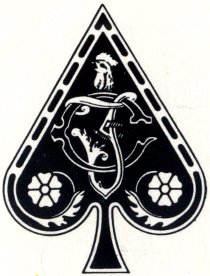
Naipes ‘Cassino’ de Don Clemente
Naipes ‘Cassino’ de Don Clemente, Pasatiempos Gallo S.A., Querétaro, Mexico, c.1988
The Ace of Spades and one of the two Jokers gives the manufacturer's name and address as: Pasatiempos Gallo S.A., Apdo. postal 250, Querétaro, Mexico. The reverse features an advertisement for Polaroid copying.
Right: The Ace of Spades has a cockerel's head and the initials ‘CJ’ incorporated into the design, which refers to the original manufacturer's name, ‘Clemente Jacques’ and the ‘Gallo’ trademark which was acquired by Don Clemente in 1982.
Standard Anglo-American packs such as the example shown here were produced by Clemente Jacques y Cia since at the least the 1950s, often with pictorial back designs, and then by Pasatiempos Gallo S.A. since c.1975. Only slight design details have changed over the years on the Ace of Spades. The court card designs are loosely copied from those published by the U.S. Playing Card Co.
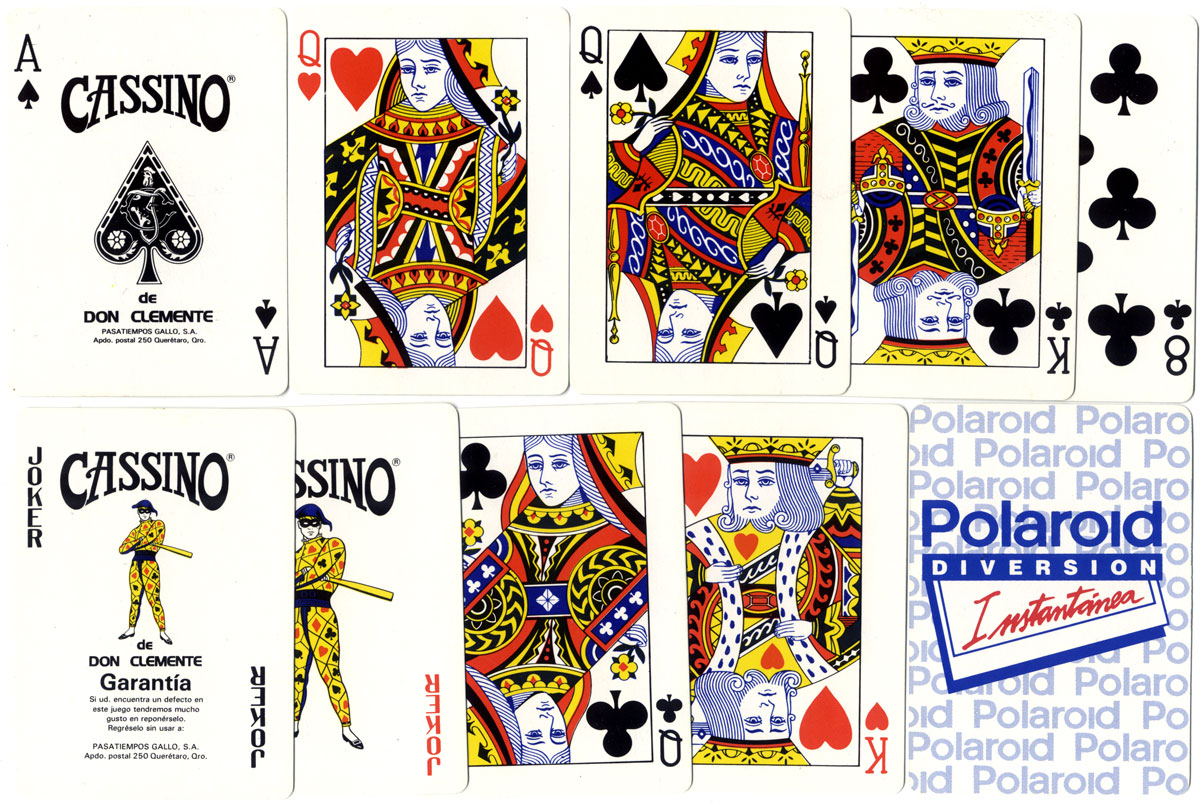
Above: Naipes ‘Cassino’ de Don Clemente, Pasatiempos Gallo S.A., Mexico, c.1988. Cassino (with double 's') is located in Italy but the joker design is copied from Catel & Farcy (Paris)►
See also: Mexico homepage • Naipe Victoria • Naipes Nacionales • Souvenir of Mexico • El Fenix • Las Dos Torres • Canasta • El León • Gallo • Baraja Taurina • Aztec Playing Cards • Aeronaves de Mexico • Anonymous Manufacturers • La Cubana • Camacho • Pronaco • Maya Playing Cards • Soberano • Editorial RAF • Pierrot • Acapulco Souvenir • Juegos y Fichas • Naipes Gacela • Bartolo Borrego • Munguia
References:
García Martín, Enrique: Clemente Jacques, in LA SOTA no.15, Asescoin, Madrid, September 1996
By Simon Wintle
Spain • Member since February 01, 1996 • Contact
I am the founder of The World of Playing Cards (est. 1996), a website dedicated to the history, artistry and cultural significance of playing cards and tarot. Over the years I have researched various areas of the subject, acquired and traded collections and contributed as a committee member of the IPCS and graphics editor of The Playing-Card journal. Having lived in Chile, England, Wales, and now Spain, these experiences have shaped my work and passion for playing cards. Amongst my achievements is producing a limited-edition replica of a 17th-century English pack using woodblocks and stencils—a labour of love. Today, the World of Playing Cards is a global collaborative project, with my son Adam serving as the technical driving force behind its development. His innovative efforts have helped shape the site into the thriving hub it is today. You are warmly invited to become a contributor and share your enthusiasm.

Leave a Reply
Your Name
Just nowRelated Articles
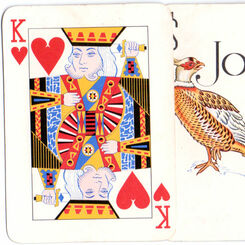
Pedro Domecq
Anglo-American pattern for Pedro Domecq Mexican brandy made by Productos Leo S.A., c.2000.

America Online Beach
America Online Beach playing cards, Spanish suit system, non-standard designs, 2006
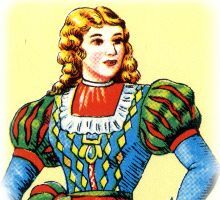
Pasatiempos Gallo
Following their acquisition of Clemente Jacques y Cia in 1967, the playing card business was taken o...
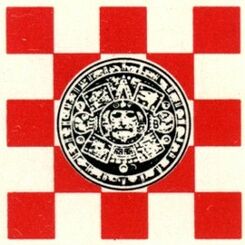
Nutrimientos Purina
Nutrimientos Purina (Purina pet foods) advertising playing cards produced by Miguel Galas S.A. (Brow...
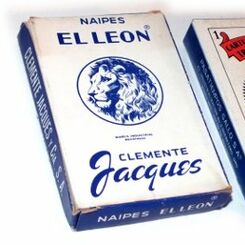
El León
Naipes El León by Clemente Jacques y Cia.
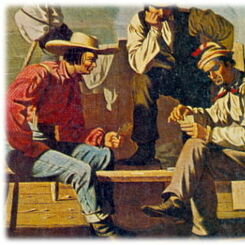
Las Dos Torres
Naipe Extra 'Las Dos Torres' manufactured by Pasatiempos Gallo S.A. de C.V., Mexico.

El Fenix
Naipe Fino 'El Fenix' playing cards by Clemente Jacques y Cia, Mexico.

Grupo Editorial RAF S.A.
Grupo Editorial RAF S.A. de C.V. (founded 1962) has branches throughout Mexico.

Advertising & publicity playing cards by Joker S.A.
Advertising and publicity playing cards manufactured by Joker S.A.
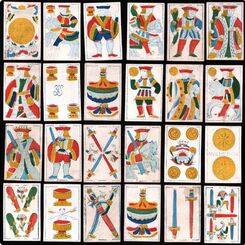
Bartolo Borrego, Mexico
40-card Spanish-suited woodblock and stencil pack made in Mexico by Bartolo Borrego, 1836.

Anonymous Mexican Playing Cards c.1825
Anonymous Mexican playing cards, finely engraved and coloured on good card stock, first quarter of t...
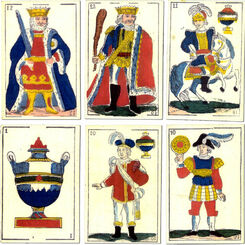
Llombart pattern from Mexico
Cards from a Mexican pack c.1835; maker unknown.
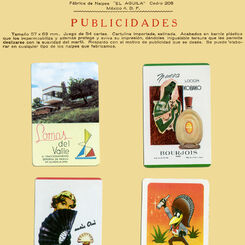
Advertising Playing-Cards by La Cubana, S.A, Mexico c.1960
Advertising Playing-Cards by La Cubana, S.A. (Fabrica de Naipes El Aguila), Mexico, c.1960.

Naipes Goliat
Naipes Goliat, La Cubana, S.A. (Fabrica de Naipes El Aguila), Mexico, c.1960
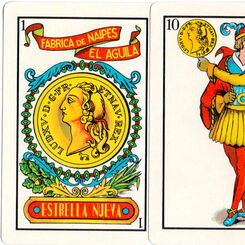
Naipes Estrella Nueva
Naipes Estrella Nueva, La Cubana, S.A. (Fabrica de Naipes El Aguila), Mexico, c.1960
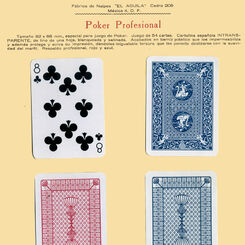
Naipes Poker Profesional
Naipes Poker Profesional, La Cubana, S.A. (Fabrica de Naipes El Aguila), Mexico, c.1960.
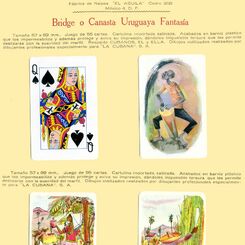
Naipes Bridge o Canasta Uruguaya,
Naipes Bridge o Canasta Uruguaya, La Cubana, S.A. (Fabrica de Naipes El Aguila), Mexico, c.1960.

Naipes Bridge Profesional
Naipes Bridge Profesional, La Cubana, S.A. (Fabrica de Naipes El Aguila), Mexico, c.1960.
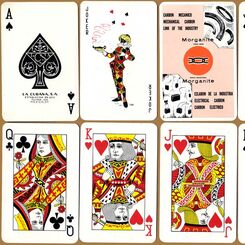
Bridge advertising playing cards by La Cubana
Bridge advertising playing cards for Morganite Carbon, manufactured by La Cubana, S.A., Tulipan 108,...
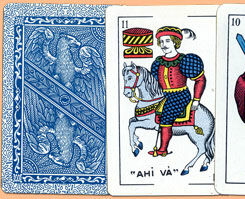
La Cubana, S.A.
La Cubana were successors to P. Munguia, who were founded in 1872. The company closed n 1995 bringin...
Most Popular
Our top articles from the past 60 days


 Your comment here. Your comment here. Your comment here. Your comment here. Your comment here. Your comment here. Your comment here. Your comment here. Your comment here. Your comment here. Your comment here. Your comment here. Your comment here. Your comment here. Your comment here. Your comment here. Your comment here. Your comment here. Your comment here. Your comment here. Your comment here. Your comment here. Your comment here. Your comment here. Your comment here. Your comment here. Your comment here. Your comment here. Your comment here. Your comment here. Your comment here. Your comment here.
Your comment here. Your comment here. Your comment here. Your comment here. Your comment here. Your comment here. Your comment here. Your comment here. Your comment here. Your comment here. Your comment here. Your comment here. Your comment here. Your comment here. Your comment here. Your comment here. Your comment here. Your comment here. Your comment here. Your comment here. Your comment here. Your comment here. Your comment here. Your comment here. Your comment here. Your comment here. Your comment here. Your comment here. Your comment here. Your comment here. Your comment here. Your comment here.




















